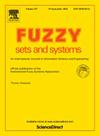Efficient algorithms for computing bisimulations for nondeterministic fuzzy transition systems
IF 3.2
1区 数学
Q2 COMPUTER SCIENCE, THEORY & METHODS
引用次数: 0
Abstract
Nondeterministic fuzzy transition systems (NFTSs) offer a robust framework for modeling and analyzing systems with inherent uncertainties and imprecision, which are prevalent in real-world scenarios. Wu et al. (2018) provided an algorithm for computing the crisp bisimilarity (the greatest crisp bisimulation) of a finite NFTS , with a time complexity of order under the assumption that . Qiao et al. (2023) provided an algorithm for computing the fuzzy bisimilarity (the greatest fuzzy bisimulation) of a finite NFTS under the Gödel semantics, with a time complexity of order under the assumption that , where l is the number of fuzzy values used in plus 1. In this work, we provide efficient algorithms for computing the partition corresponding to the crisp bisimilarity of a finite NFTS , as well as the compact fuzzy partition corresponding to the fuzzy bisimilarity of under the Gödel semantics. Their time complexities are of the order , where l is the number of fuzzy values used in plus 2. When , this order is within . The reduction of time complexity from and to is a significant contribution of this work.
计算非确定模糊过渡系统二拟合的高效算法
非确定性模糊过渡系统(NFTS)为建模和分析具有内在不确定性和不精确性的系统提供了一个稳健的框架,而这种不确定性和不精确性在现实世界的场景中非常普遍。Wu等人(2018)提供了一种计算有限NFTS S=〈S,A,δ〉的干脆二相似度(最大干脆二拟合)的算法,在|δ|≥|S||的假设下,时间复杂度为O(|S|4⋅|δ|2)阶。乔等人(2023)提供了一种在哥德尔语义下计算有限 NFTS S 的模糊二相似度(最大模糊二拟合)的算法,在假设|δ|≥|S|的情况下,时间复杂度为阶 O(|S|4⋅|δ|2⋅l),其中 l 是 S 中使用的模糊值数加 1。在这项工作中,我们提供了计算与有限 NFTS S 的清晰相似性相对应的分区以及与哥德尔语义下 S 的模糊相似性相对应的紧凑模糊分区的高效算法。它们的时间复杂度为 O((size(δ)logl+|S|)log(|S|+|δ|)),其中 l 是 S 中使用的模糊值数加 2。当|δ≥||S|时,这个阶次在 O(|S|⋅|δ|⋅log2|δ|) 以内。时间复杂度从 O(|S|4⋅|δ|2) 和 O(|S|4⋅|δ|2⋅l) 降低到 O(|S|⋅|δ|⋅log2|δ|) 是这项工作的重大贡献。
本文章由计算机程序翻译,如有差异,请以英文原文为准。
求助全文
约1分钟内获得全文
求助全文
来源期刊

Fuzzy Sets and Systems
数学-计算机:理论方法
CiteScore
6.50
自引率
17.90%
发文量
321
审稿时长
6.1 months
期刊介绍:
Since its launching in 1978, the journal Fuzzy Sets and Systems has been devoted to the international advancement of the theory and application of fuzzy sets and systems. The theory of fuzzy sets now encompasses a well organized corpus of basic notions including (and not restricted to) aggregation operations, a generalized theory of relations, specific measures of information content, a calculus of fuzzy numbers. Fuzzy sets are also the cornerstone of a non-additive uncertainty theory, namely possibility theory, and of a versatile tool for both linguistic and numerical modeling: fuzzy rule-based systems. Numerous works now combine fuzzy concepts with other scientific disciplines as well as modern technologies.
In mathematics fuzzy sets have triggered new research topics in connection with category theory, topology, algebra, analysis. Fuzzy sets are also part of a recent trend in the study of generalized measures and integrals, and are combined with statistical methods. Furthermore, fuzzy sets have strong logical underpinnings in the tradition of many-valued logics.
 求助内容:
求助内容: 应助结果提醒方式:
应助结果提醒方式:


